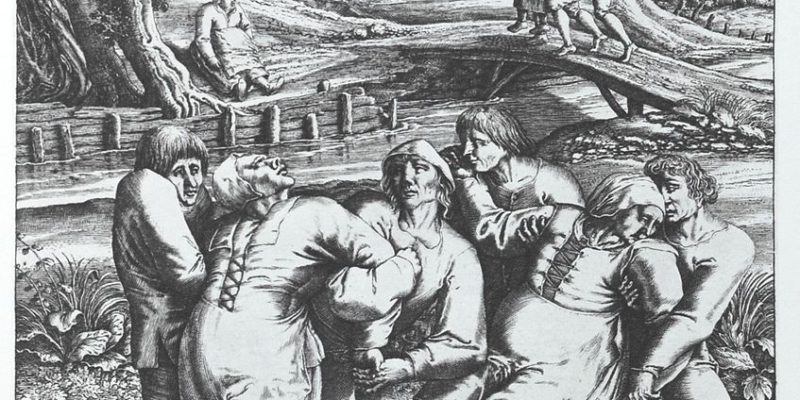A. Five hundred years ago in July, a strange mania seized the city of Strasbourg. Citizens by the hundred became compelled to dance, seemingly for no reason — jigging trance-like for days, until unconsciousness or, in some cases, death. Ned Pennant-Rea on one of history’s most bizarre events.
B. On a hastily built stage before the busy horse market of Strasbourg, scores of people dance to pipes, drums, and horns. The July sun beats down upon them as they hop from leg to leg, spin in circles and whoop loudly. From a distance they might be carnival revellers. But closer inspection reveals a more disquieting scene. Their arms are flailing and their bodies are convulsing spasmodically. Ragged clothes and pinched faces are saturated in sweat. Their eyes are glassy, distant. Blood seeps from swollen feet into leather boots and wooden clogs. These are not revellers but “choreomaniacs”, entirely possessed by the mania of the dance.
C. In full view of the public, this is the apogee of the choreomania that tormented Strasbourg for a midsummer month in 1518. Also known as the “dancing plague”, it was the most fatal and best documented of the more than ten such contagions which had broken out along the Rhine and Moselle rivers since 1374. Numerous accounts of the bizarre events that unfolded that summer can be found scattered across various contemporary documents and chronicles compiled in the subsequent decades and centuries. A chronicle from 1636 relates a tragic ending: “In the year 1518 AD … there occurred among men a remarkable and terrible disease called St Vitus’ dance, in which men in their madness began to dance day and night until finally they fell down unconscious and succumbed to death”.
D. According to various chronicle, it all started with one woman. Frau Troffea started dancing on July 14th on the narrow cobbled street outside her half-timbered home. As far as we can tell she had no musical accompaniment but simply “began to dance”. Ignoring her husband’s pleas to stop, she continued for hours, until the sky turned black and she collapsed out of exhaustion. The next morning she was up again on her swollen feet and started dancing incessantly.
E. The mania possessed Frau Troffea for between four and six days, at which point the frightened authorities intervened by sending her in a wagon thirty miles away to Saverne. There she might be cured at the shrine of Vitus, the saint who it was believed had cursed her. But some of those who had witnessed her strange performance had begun to mimic her, and within days more than thirty choreomaniacs were in motion, some so monomaniacally that only death would have the power to intervene.
F. The more citizens this unusual plague afflicted, the more desperate the council became to control it. The clergy held it to be the work of a vengeful Saint Vitus, but the councillors listened instead to physicians, declaring the dance to be “a natural disease”. The physicians then recommended that the victims must dance themselves free of it. Carpenters and tanners were ordered to transform their workplaces into temporary dance floors. To keep the patients in motion and so expedite their recovery, dozens of musicians were paid to play drums, fiddles, pipes, and horns, with healthy dancers brought in complimentarily for further encouragement. The authorities hoped to create the optimal conditions for the dance to exhaust itself.
G. It backfired horribly. Being more inclined to a supernatural than a medical explanation of the dance, most of the onlookers saw in the frenzied movements a demonstration of the magnitude of Saint Vitus’ fury. None being free of sin, many were lured into the mania. The Imlin family chronicle records that within a month the plague had seized four hundred citizens.
H. The privy council ordered the stages to be pulled down. If the choreomaniacs must continue their disturbing movements then they now must do so out of sight. The council went further, prohibiting almost all dance and music in the city until September. This was no small thing for a culture in which communal dancing was central. Sebastian Brant, a chancellor and author of The Ship of Fools (1494), detailed the exception to the ban: “if honourable persons wish to dance at weddings or celebrations of first Mass in their houses, they may do so using stringed instruments, but they are on their conscience not to use tambourines and drums.” Presumably strings were deemed less likely than percussion to bring on the mania.
I. Several modern historians have argued that the dancing plagues of mediaeval Europe were caused by ergot, a mind-altering mould found on the stalks of damp rye, which can cause twitching, jerking, and hallucinations — a condition known as St Anthony’s Fire. However, historian John Waller has debunked the ergot hypothesis in his brilliant book on the dancing plague, A Time to Dance, a Time to Die (2009). Yes, ergot can cause convulsions and hallucinations, but it also restricts blood flow to the extremities. Someone poisoned by it simply could not dance for several days in a row.
J. One way to elucidate the dancing plague is to consider the trance states people reach today. In cultures around the world, including in Brazil, Madagascar, and Kenya, people enter trances deliberately during ceremonies or involuntarily during periods of extreme stress. Once entranced, their perception of pain and exhaustion is marginalised. Waller describes the spread of the dancing plague as an example of psychic contagion, and he draws a parallel with the laughing epidemic that engulfed a region of Tanganyika (modern-day Tanzania) in 1963. When a couple of girls at a local school got the giggles, their friends followed suit until two-thirds of the pupils were laughing and crying uncontrollably and the whole school had to be shut down. Once home, the pupils “infected” their families and soon whole villages were consumed by hysterics. Doctors recorded several hundred cases, lasting a week on average.
K. Of course, the dancing plagues have another parallel — modern rave culture. Though usually without the bloody feet and pleas for mercy of our sixteenth-century choreomaniacs, and often with a little chemical help, it is not uncommon for partygoers to dance for days with few breaks, forgoing sleep and food, sometimes shifting their feet with poise and balance, and sometimes leaping with none. Should one such reveller — perhaps fuelled by a particularly potent dancefloor potion — be transplanted onto the horse market stage of early modern Strasbourg half a millennium ago, they might not feel entirely out of place.
Questions 1-8
Complete the summary below. Choose your answers in questions 1 to 9.
Around half a … (1) … ago, many people of Strasbourg were found dancing … (2) … for days without rests. Some … (3) … injuries to their feet. Some even died.
As the “dancing plague”… (4) …, officials became … (5) … and asked doctors for help. Their … (6) … was that the people affected must not stop dancing. Therefore, the officials invited … (7) … dancers and musicians to assist with the situation. However, the plague became out of … (8) … and the authorities ordered that all dancing must take place indoors.
Questions 9-15
Do the following statements agree with the views of the writer in the reading passage? In questions 9 to 15 choose
YES if the statement agrees with the writer
NO if the statement contradicts the writer
NOT GIVEN if it is impossible to say what the writer thinks about this
IELTS Reading #1
Question 1 |
banquet | |
progress | |
millennium | |
century |
Question 2 |
uncontrollably | |
rave | |
concerned | |
reliably |
Question 3 |
developed | |
suffered | |
concerned | |
departed |
Question 4 |
departed | |
exhilarated | |
developed | |
suffered |
Question 5 |
volunteer | |
exhilarated | |
suffered | |
concerned |
Question 6 |
progress | |
magic | |
bakery | |
advice |
Question 7 |
magic | |
banquet | |
departed | |
volunteer |
Question 8 |
progress | |
volunteer | |
hand | |
traffic |
Question 9 |
Yes | |
Not Given | |
No |
Question 10 |
Yes | |
No | |
Not Given |
Question 11 |
No | |
Yes | |
Not Given |
Question 12 |
Not Given | |
Yes | |
No |
Question 13 |
Not Given | |
Yes | |
No |
Question 14 |
No | |
Yes | |
Not Given |
Question 15 |
Yes | |
No | |
Not Given |






Comments